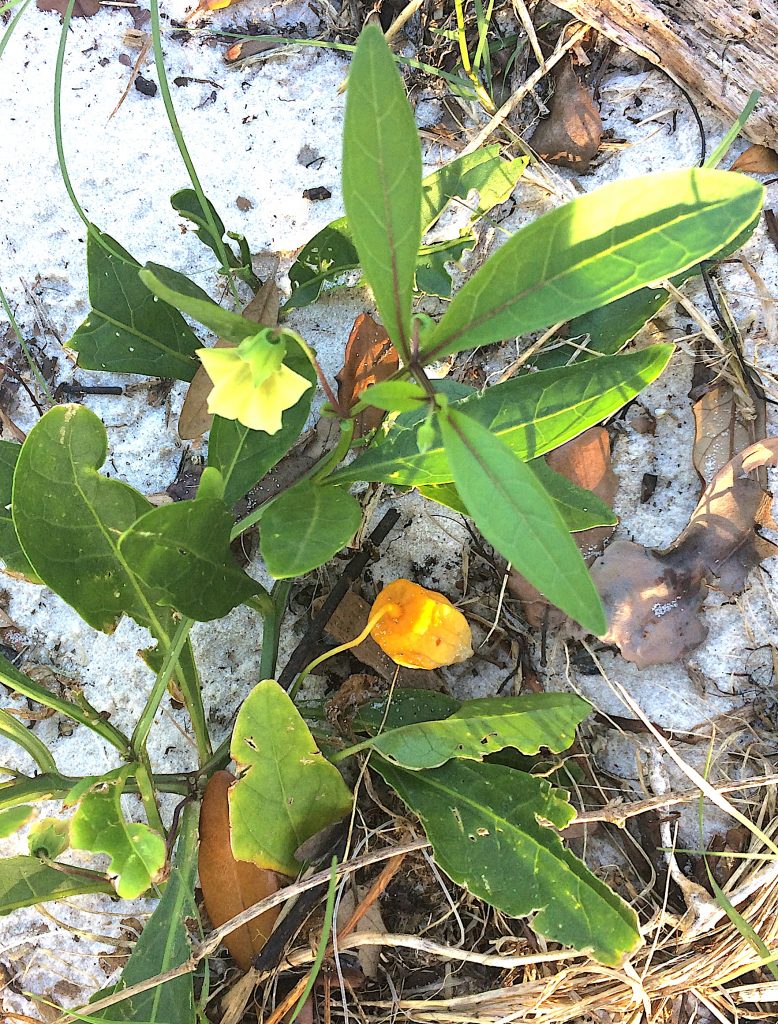
As the Ground Cherry ripens the husk turns golden. Photo by Green Deane
It was fruit day Sunday during our class in Port Charlotte. The champangne mangoes were just ripening. A great tasty surprise was many ground cherries. There are several species locally and those were Physalis viscosa. I pocketed some seeds for planting. Behind season were coco-plums (we only found three) and Java Plums were only bosoming. We did get to taste some non-commercial Dragon Fruit from some candle cactus.
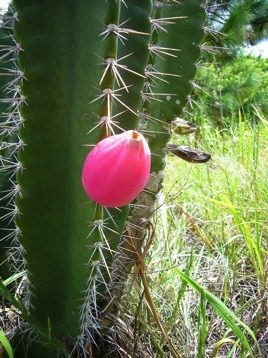
Cereus cactus fruit is wild Dragon Fruit. Photo by Green Deane
Folks also think cactus, like palms, are warm weather residents. In fact, cactus are native to 46 of the 50 US states and naturalized in one of those four (Hawaii.) The only states they are not native in other than Hawaii are Maine, New Hampshire and Vermont — the farthest away from their origin in central America. That said, I knew where there were some surviving cactus behind an old homestead in Maine. They looked quite ratty every spring but somehow managed to survive. Cactus have been naturalized in many parts of the world. Malta comes to mind where they are living fences and a “traditional” source of wine and spirits even though they are native to Mexico and south.
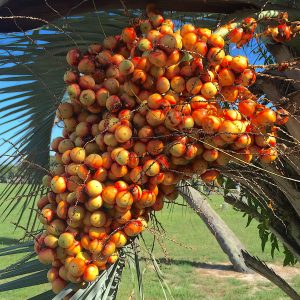
Pindo Palm can fruit almost anytime. Photo by Green Deane
July is passing and that means many different things to foragers depending upon your location on the rotation. In a particular latitudinal belt around the world it means the Pindo Palms are in fruit — my favorite after coconut which also fruit in south Florida. And don’t think Pindo Palms are just a warm region plant. They grow as far north as Washington DC and elsewhere in under protection. Also call the Jelly Palm, they were standard landscaping for every southern home because you can make a jelly from the fruit without having to add any pectin or sugar. However, just as year-to-year production of wine changes with the weather so does the quality of the pindo jelly. It has vintages. Some years you will have to add a little sugar, other years some pectin. But most years it is just right. I also like to eat the fruit right off the palm. I enjoy the pulp and spit out the fiber. Some folks just eat all the fiber and pulp. The seed kernel are easy to get out and taste intensely of coconut. Pindo wine is always cloudy, though, because of the pectin, but after 14 glasses you don’t notice.
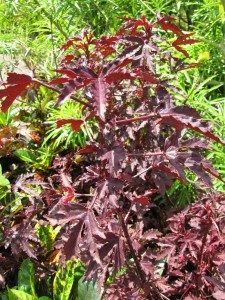
False roselle leaves are edible raw or cooked, Photo by Green Deane
A species responding to the warmer and wetter weather is the False Roselle. It grows “wild” in my back yard. I noticed this past week seedlings coming up. To the eyes of anyone who looked at plants in a northern climate ones first guess on seeing the False Roselle is that it is a misplaced Red Maple. The resemblance is superficial but close enough to give one pause. Though I would not label the tree with a Pampered Chef epitaph but to me the leaves say “Salads and Stir Frys. Its red leaves — true red, not the reddish green of the true Roselle — are tart and just rightly so. They go into salads well. More so, they take to quick vegetable-lush stir fries and do not lose their color or taste on cooking. It’s even a good tree to nibble on wherever you find it. The species, interestingly, is not long-lived, a few years at best like Elderberry. But it spreads easily and can be grown from seeds or better from shoots. Just cut off a few young branches, take off the lower leaves, put the stems in water and within a couple of weeks you will have well-rooted twigs to plant. In fact I over-winter some every year. A heavy frost or a light freeze will die them back to the roots. Young trees will come back in the spring, but often older plants won’t. So I raise a few in the winter to make sure I can restock in the summer. The blossoms are edible as well and a juice can be made from the caylexs. Red Maple are more iffy. Red Maple leaves are bitter but humans can eat a few of them. However, Red Maple leaves are deadly to horses and they will eat them. Keep your horses away from Red Maples. You can read about the False Roselle here

Classes are held rain or shine (but not during hurricanes.)
Foraging Classes: My move from Altamonte Springs to Lithia is done, hoping to get back to a more regular schedule.
Saturday, July 16th, Wickham Park: 2500 Parkway Drive, Melbourne, FL 32935-2335. 9 a.m. Meet at the “dog park” inside the park
Saturday, July 17th Colby-Alderman Park: 1099 Massachusetts Street, Cassadaga. 9 a.m.. Meet at the bathrooms.
Saturday, July 23rd, Eagle Park Lake, 1800 Keene Road, Largo, FL 33771. Meet at the pavilion near the dog park. 9 a.m.
Sunday, July 24th, George LeStrange Preserve, 4911 Ralls Road, Fort Pierce, FL, 34981. 9 a.m.
For more information, the pre-pay for a class, or sign up go here.
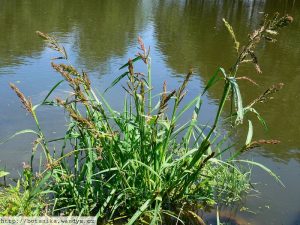
Barnyard Grass is the most misnamed grass in the world.
One would think that with a name like “Barnyard Grass” one would find it in barnyards. But no. It is probably safe to say you will rarely find Barnyard Grass in a barnyard. Why? Because Barnyard Grass likes to grow in water, lots of water. You can easily find it in ponds, streams and drainage ditches but not barnyards unless it is growing directly under the roof drain spout in a very low, wet spot. In all my years of foraging I have seen Barnyard Grass once in a barnyard but dozens of times in water. In wet areas look for a tall grass that resembles wheat. The stems will be hairy and usually purple at the base. One easy place to find them locally is in dried up lakes. Often at the still-damp low spot Barnyard Grass will colonize the entire low spot. Not a native it comes in season at the same time and one can find it seeding now. The grain is a bit more coarse than wheat but can be harvested, prepared and used the same way. You can read about Barnyard Grass here

You get the USB, not the key.
Changing foraging videos: As my WordPress pages are being updated the video set will go away. My nine-DVD set of 135 videos has been selling for seven years. They are the same videos I have on You Tube. Some people like to have a separate copy. The DVD format, however, is becoming outdated. Those 135 videos plus 15 more are now available on a 16-gig USB drive. While the videos can be run from the DVDs the videos on the USB have to be copied to your computer to play. They are MP4 files. The150-video USB is $99 and the 135-video DVD set is now $99. The DVDs will be sold until they run out then will be exclusively replaced by the USB. This is a change I’ve been trying to make for several years. So if you have been wanting the 135-video DVD set order it now as the price is reduced and the supply limited. Or you can order the USB. My headache is getting my WordPress Order page changed to reflect these changes. We’ve been working on it for over three weeks. However, if you want to order now either the USB or the DVD set make a $99 “donation” using the link at the bottom of this page or here. That order form provides me with your address, the amount — $99 — tells me it is not a donation and in the note say if you want the DVD set or the USB.

Green Deane Forum
Want to identify a plant? Perhaps you’re looking for a foraging reference? You might have a UFO, an Unidentified Flowering Object, you want identified. On the Green Deane Forum we — including Green Deane and others from around the world — chat about foraging all year. And it’s not just about warm-weather plants or just North American flora. Many nations share common weeds so there’s a lot to talk. There’s also more than weeds. The reference section has information for foraging around the world. There are also articles on food preservation, and forgotten skills from making bows to fermenting food.
This is weekly newsletter 515, If you want to subscribe to this free newsletter you can find the sign-up form in the menu at the top of the page.
To donate to the Green Deane Newsletter click here.

